1966 Aston Martin DB6 4.0 vs. 1965 Jaguar E-type 4.2 FHC Series 1
Which do we think is the best Sixties coupe out of an iconic E-type 4.2 and an equally famous Aston Martin DB6 4.0? There's only one way to find out and that's to drive these two beautiful British sports cars side-by-side. Words and photography Paul Walton.
THE SIXTIES Jaguar E-type Series 1 FHC vs Aston Martin DB6
We pitch two of the most iconic cars from the Sixties against each other, the E-type Series 1 4.2 and the Aston Martin DB6 4.0
Let’s be honest here, if you owned either a Jaguar E-type Series 1 or an Aston Martin DB6 when they were new you were definitely winning at life. No other cars still represent the zenith of Sixties British glamour or say you’ve arrived in all senses of the word quite as much as these two.
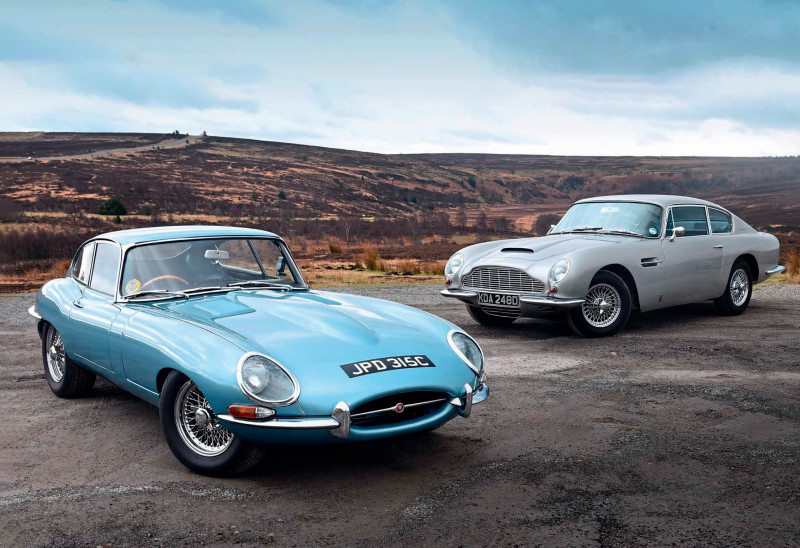
The E-type is one of the most famous cars in the world
A famous and desirable duo they may be but whether it’s comparing a Monet with a Manet, a 2002 Chateau Lafite Rothschild with a 1951 Penfolds Grange Hermitage or even Eastenders and Coronation Street, one always has to be better than the other. So which out of this pair of icons do we put ahead today?
Splitting them won’t be due to their looks alone since both are as close to automotive perfection as you can get. The E-type is clearly the smaller of the two and, derived from the Le Mans-winning D-type, kept the same lithe, sinewy and clean looks as the racing car.
This fixedhead coupe is perhaps the most desirable of the early cars: a Series 1 but with the 4,235cc version of the XK engine. Arriving in 1965, although at 265bhp the power remained the same as the 3.8, the update offered improved torque and flexibility.
“The new 4.2-litre Jaguar is a very great car indeed,” said Autosport magazine in its 23 October 1964 issue. “Almost unbelievably smooth, quiet and flexible, it is comfortable on good and rough surfaces alike. Yet it has tremendous performance instantly on tap but will idle for hours in city traffic without complaint.”
However, unlike the later, more bloated series, the engine update didn’t change the design and so the familiar glass-covered headlights and large, oval-shaped bonnet vent remain that together make the E-type one of the most famous cars in the world. But, I’d argue, not quit as famous as the Aston Martin even though it’s not the model most think it is. Introduced in October 1966, the DB6 featured a higher roof line plus a shortened Kamm tail than the outgoing DB5 to counteract rear lift. Having a separate body and chassis results in the DB6 towering over the compact E-type with its modern unibody. But its size gives Aston more of a muscular and beefier appearance than the dainty Jaguar.
This eagerness is encouraged by Aston’s five-speed gearbox
Yet by having the same basic proportions and the same shape of vaned grille as the DB5 plus this example being in Silver Birch, it might not be the model famed celluloid spy, James Bond, has driven on and off since 1964, but everyone will be able to recognise it as an Aston Martin because of his escapades. It’s about now when we need to address the elephant in the room; at £5,000 in 1966, the Aston Martin was £3,000 more expensive than the Jaguar, a huge £60k in today’s money. And that difference is even larger today; while this gorgeous 1965 E-type 4.2 FHC is worth around £150,000, the DB6 from 1966 is £250,000 more. But does it deserve the higher sum? On first glance, maybe. Whether it’s due to the Bond connection or simple, old-fashioned rarity – a mere 1,788 DB6s were produced compared to 38,412 E-type Series 1s – but I can’t deny the Aston has slightly more allure than the E-type. Those who witnessed the cars driving in convoy through the beautiful Yorkshire Moors for this feature certainly thought so since it was the silver car that got all the attention, the poor old E-type barely given a first never mind a second glance.
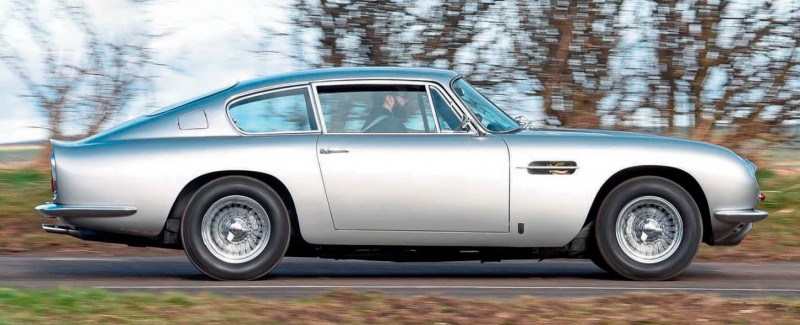
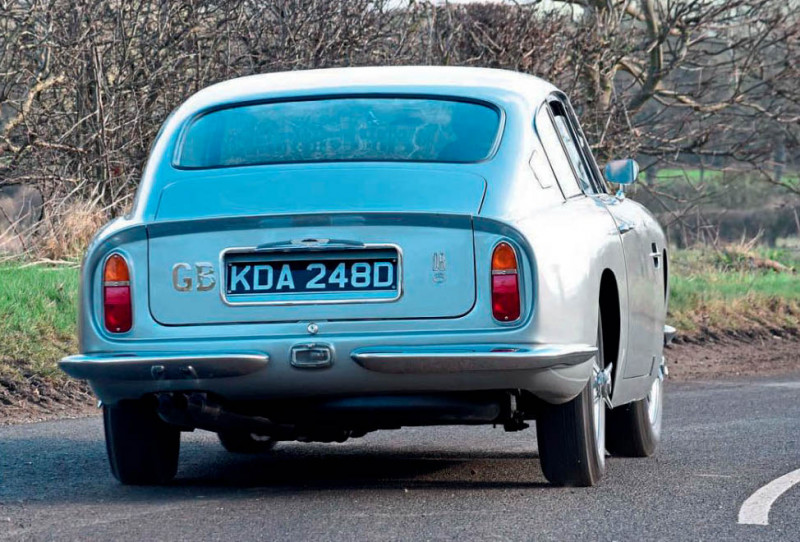
1966 Aston Martin DB6 4.0
And so, despite messing around with cars for almost 25 years, even I’m taken in by the charm of the Aston and cannot wait to get behind the wheel. Large and roomy, it’s certainly more comfortable than the E-type whose cockpit is so tight you feel like you’re wearing it rather than sitting in it. Plus, by being 3.75in longer than the DB5, the extra length allowed Aston to insert two admittedly tight rear seats; to have the same in the Jaguar you’d need the less proportionally perfect E-type 2+2 which arrived in the same year as the DB6. Although it’s clearly better built (but so it should have been considering the huge difference in price) the chrome and art deco-style shape of the dashboard makes the Aston’s dash appear overly twee and convoluted compared to the E-type’s simple, racing inspired layout.
The DB6 is powered by a 3,995cc straight-six that was designed by Aston’s long-term engine designer, Tadek Marek. Like the XK unit that first saw service with the 1948 XK 120, this wasn’t a fresh engine either. First used for the DBR2 racing car from 1956 it was modified for road use, starting with the DB4 two years later, and only replaced by Marek’s 5.3-litre V8 in 1969.
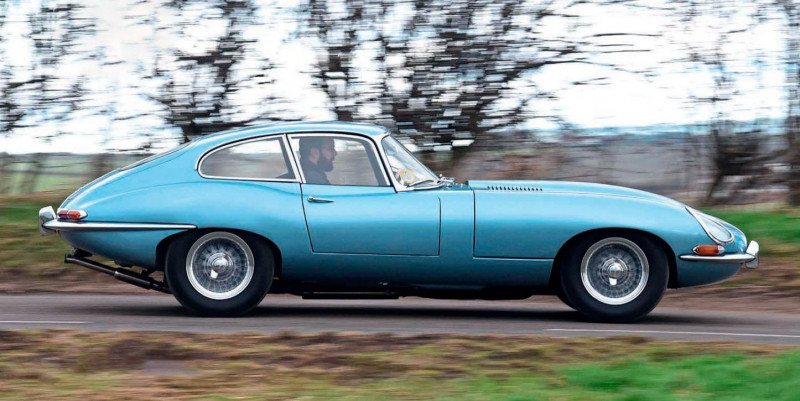

1965 Jaguar E-type 4.2 FHC Series 1
Founded in 1913, Aston’s history is even longer than Jaguar’s and even more complicated with several owners in that time. It’s most famous era is arguably the Fifties and Sixties when it was owned by British industrialist and tractor magnate, David Brown. After buying the ailing company in 1947, the subsequent DB range are some of the most celebrated British sports cars of all time. Even though Brown had sold the company in 1972 and it had been owned by Ford since 1989, when a new model was revealed four years later, as an immediate link to the earlier cars it was christened the DB7. Aston Martin has continued to use the name ever since with its current range topper being the DB11. Due to all this history it’s with more than a little anticipation – or perhaps fear when I remember its value – as I turn the DB6’s ignition key and hear the big engine fire with a purposeful growl.
Like Aston’s previous models from the 1958 DB4 onwards, the DB6 utilises Carrozzeria Touring’s Superleggera (or superlight) technology that consists of aluminium panels on a light tubular framework. Although this makes the car lighter than it would have been if made in the traditional way, it still weighs a hefty 1,525kg, 200kg more than the E-type. But thankfully, with 325bhp the Aston’s free-revving straight-six is still strong enough to result in a hard and eager acceleration – when Autocar tested the car for its 25 February 1966 issue, the writer managed to reach 60mph in 6.5 seconds, half a second faster than the E-type 4.2 FHC that had been tested by Motor magazine two years previously.
This eagerness is encouraged by the five-speed gearbox that’s not only remarkably easy to use for a 50-year-old unit but allows the car to cruise more comfortably than the E-type with its Jaguar-designed manual four. Said Autocar; “The car is deceptively fast, streaking along at a relaxed 120mph as effortlessly as some other cars manage 80mph.” Six decades later, that hasn’t changed. Due to the five-speed ‘box and the smoothness of the engine, I certainly find the DB6 the more relaxed of the two. But if I’m being honest, the DB doesn’t feel as sharp as the E-type; the steering isn’t as accurate while the physical throws of the transmission are almost as long as the car itself and don’t lend themselves to short, snappy changes. And the Aston’s engine might have 60bhp over the E-type’s, but it never feels as eager or responsive and neither does it sound as distinctive. Despite all of the Aston’s considerable charm I’m still missing that familiar twin-cam wail of the Jaguar’s XK unit.
Having a live axle, it doesn’t ride or handle as well either and can’t disguise its bulk through corners when fast changes of direction unsettle the body. Put all of this together and it makes the DB6 more of a GT in the same way the XJ-S would be a decade later rather than a blue-blooded sports car. But is the car’s unmistakable magnetism still able to win out over the sportier E-type?
I certainly prefer the Aston’s spacious interior when I switch cars and climb into the Jaguar’s cramped cockpit. As well as banging my head on the low roof, I also need to be double-jointed to get both legs over the wide sill and then fit under the large, wood-rimmed steering wheel. One of my favourite aspects of driving an E-type is looking through the screen and down the long, voluptuous bonnet. Although just as exciting in the Aston when, peering over its large bonnet vent, I feel like the aforementioned secret agent on a mission, I still prefer the Jaguar since the view makes any journey look and feel like I’m at LeMans. The 4.2-litre XK unit might have 60bhp less than DB6’s 4.0 but it still feels a little more eager and a tad more responsive, plus despite what the motoring magazines of the time found, quicker too. As mentioned earlier, the Jaguar-designed ‘box is faster and more accurate than the five-speeder in the Aston, with shorter changes which aids acceleration. I do miss the fifth gear, though, since the noise of the high-revving engine can become hard work over long distances, hence why many E-type owners chose to fit a modern five-speed unit which transforms the car.
Where the E-type really shines is its handling. Fitted with Jaguar’s famous independent rear suspension, it rides much better t an the Aston, not feeling as lose or squirrely over rough surfaces. With perfectly controlled body roll and perfectly weighted steering, I’m able to attack corners faster than in the DB6. Aston’s 1959 victory of the LeMans 24-hour race might have come two years after the D-type’s final success there, but the E-type feels much closer-related to its competition ancestor than the DB6 does to its own, the DBR1.
Just as I have a favourite from my earlier choices (Monet every time, I don’t care as long as it’s red and I’d rather stick pins in my eyes rather than watch either) so I do with these two cars. Although there’s no denying it would be a pleasure to own an Aston Martin DB6, thanks to its better handling and responsive engine, I’d enjoy driving the E-type more so. PW
Thanks to: Classic & Sportscar Centre (www.classicandsportscar.ltd.uk) for the use of both cars featured
I’m able to attack corners faster than in the Aston
1966 Aston Martin DB6 4.0
- Engine 3 995cc inline 6
- Max Power 325bhp
- Max Torque 290lb ft
- 0-60mph 6.5 secs
- Max speed 148mph
- Transmission 5-spd man
- Price new £4,998
- Value now £400,000
1965 Jaguar E-type 4.2 FHC Series 1
- Engine 4,235cc inline 6
- Max Power 265bhp
- Max Torque 283lb ft
- 0-60mph 7.0 secs
- Max speed 150mph
- Transmission 4-spd man
- Price new £1,992
- Value now £150,000


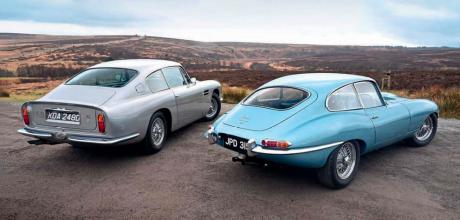
Just one more comparison road test between Jag XKE e Type and Astons DB6 — but in Cabrio form
No less interesting marked the centenary of Jaguar was a masterful piece of publishing, covering all bases of the company’s 100 years. I especially liked the biographies of nine important people and could easily have read nine more! I also liked the E-type and DB6 twin test, two cars I will never, sadly, get to buy myself but that made the article no less interesting. And sorry to read Paul Walton is suffering my issues with his XF Sportbrake. I had a similar car for a few years and similar problems, finally selling it in 2018 for – whisper it – a Honda SUV which (fingers crossed) has been bullet proof so far. Jaguar certainly needs to improve its reliability if it’s to reach another 100 years! Congratulations to all the team for such a great magazine and keep up the good work.